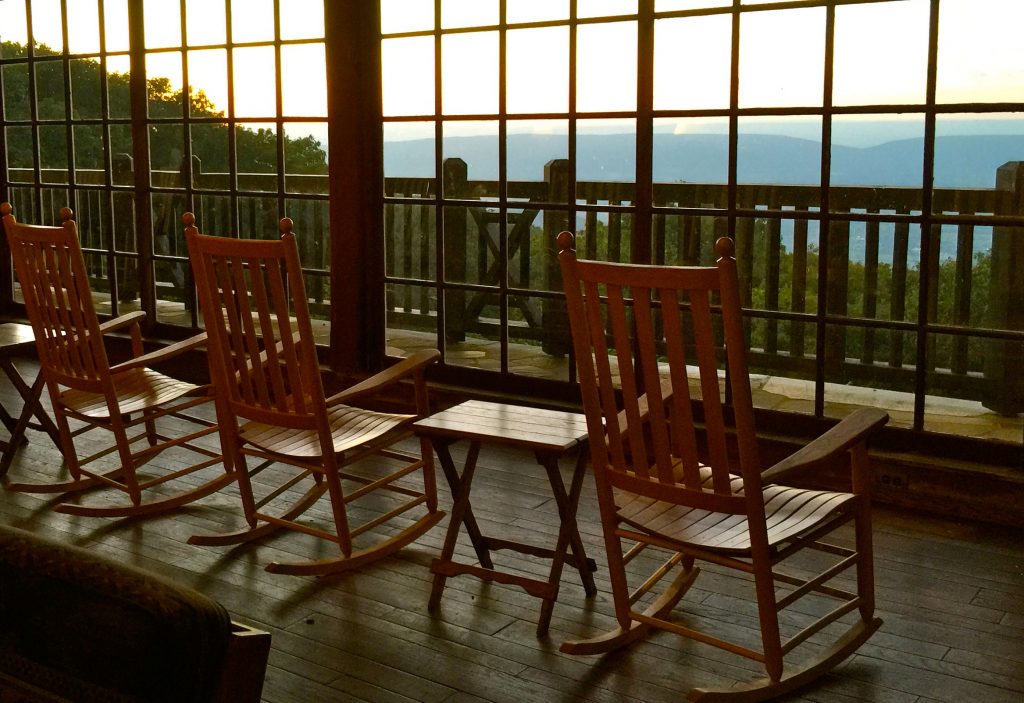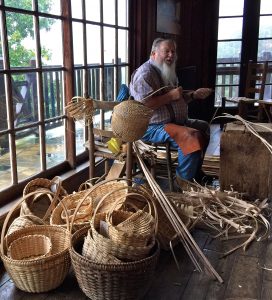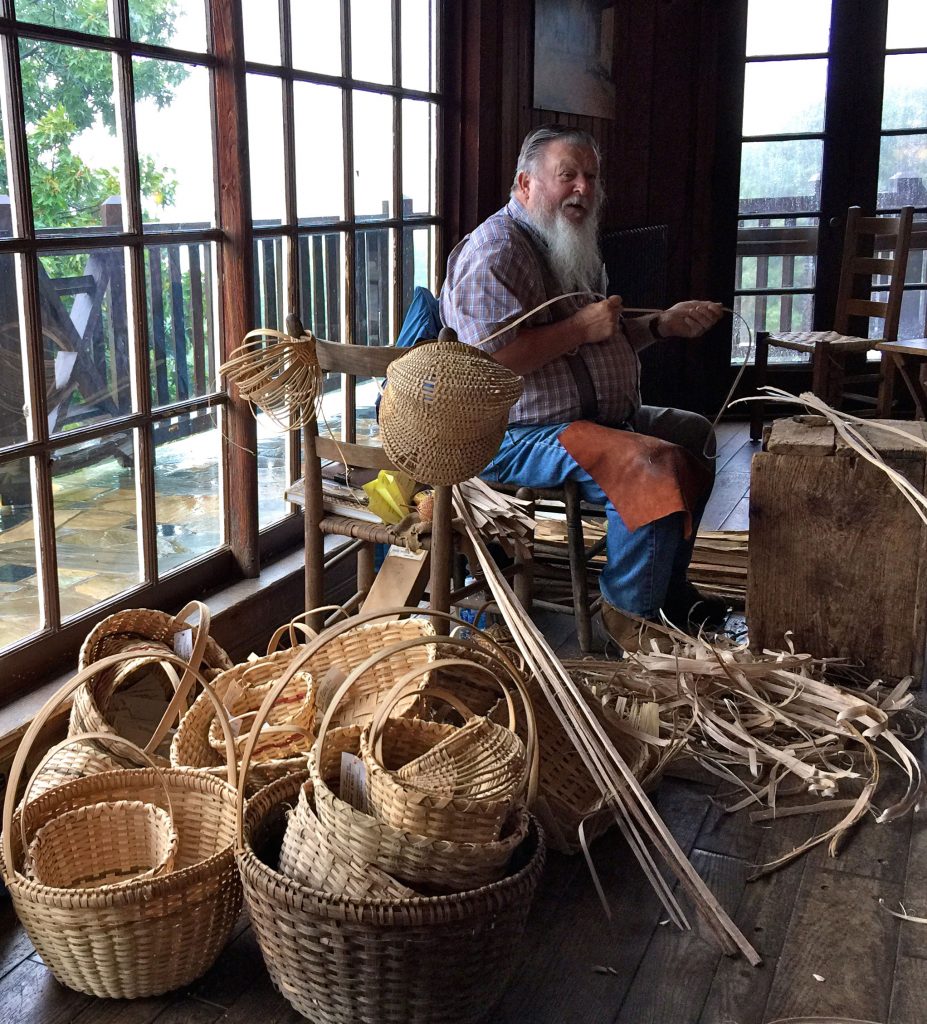Shenandoah National Park celebrates big birthday with awesome quiet
By Cheryl Blackerby
The Palm Beach Daily News (Dec. 24, 2016)
SHENANDOAH NATIONAL PARK, Va. — A cold rain fell on my wooden cabin in the misty twilight of late afternoon. As I was building a fire in the stone fireplace, I heard what sounded like a small animal running across the roof. I heard it again, then again.
Curious, I went outside to see what wildlife was on top of the cabin.
I was disappointed to find no animals, only big acorns hitting the slanted roof and bouncing down. Who knew acorns could make such a racket?
But it turned out there were animals on the ground and they were making no noise. I turned around and saw four whitetail deer — a big-eyed doe, a young buck with new antlers, and two spotted fawns — only 10 feet away, not moving as they looked at me through a thick fog.

The terrace at Big Meadows Lodge offers stunning views of Virginia’s Blue Ridge Mountains. Photo by Cheryl Blackerby
They soon went back to munching acorns, taking time to find the choicest ones, not at all bothered that I was so close. I stood in the spitting rain for 10 minutes watching them as they slowly moved past.
The next three days, the same family of deer (the doe had a bright pink tag on her ear) visited at the same time each afternoon and I watched them from my cabin’s screened porch. I was really grateful for those bouncing acorns that attracted them to my cabin.
That was just one of the many great moments of my four-day stay in Shenandoah National Park high in Virginia’s Blue Ridge Mountains.
Another rainy day, I encountered two-footed wildlife on a densely wooded mountain path. A tall man who could have been mistaken for Bigfoot, with tangled black hair hanging past his shoulders and a long thick black beard, wearing a muddy rain jacket, mud-caked rain pants and heavy backpack, stepped out of a thicket and onto the path ahead.
He didn’t say anything, just tipped the brim of his dripping leather hat in greeting as he walked past. He looked too tired to talk.
I saw him later in the Big Meadows Lodge dining room, clean and smiling. A ranger told me he and others come in off the Appalachian Trail, which runs through part of the park, to get a hot shower and hotter dinner.
Just 75 miles west of the metropolis of Washington D.C., the park’s forested mountains offer sweeping vistas of mountain peaks, river valleys and waterfalls, with memorable glimpses of lumbering black bears, bobcats, and birds ranging from majestic red-tailed hawks to flamboyant purple finches.
It has been a terrible year and a wonderful year for Shenandoah.
In April, the park experienced the second-worst fire in its history with 10,000 acres burned. But all trails affected by the blaze were opened within weeks and the park is back to normal. Hikers probably won’t see the blackened trees.
The best part of the year was the celebrations of the National Park Service’s 100th birthday, highlighted by visits from dignitaries, Girl Scout trail crews, fleets of RVs taking this opportunity to travel from one park to another, and three generations of families meeting up in this wild natural oasis so near to the congested East Coast.
This year is also the 80th anniversary of the park. Standing on a stage on Big Meadows, Franklin D. Roosevelt dedicated the new park July 3, 1936, with the United States Marine Band playing in the background.
When I was there in late October, light traffic moved slowly on Skyline Drive winding 105 miles through the park. Visitors going west can connect to the 469-mile-long Blue Ridge Parkway, which runs along the Blue Ridge, a soaring mountain chain in Virginia and North Carolina. Together, they make one of the country’s most gorgeous roads with numerous jaw-dropping overlooks that make a quick trip impossible.
The park road is open all year, and each season offers a vast public wilderness to be proud of: snow-covered mountains with icicles hanging from leafless maples and oaks, and smoke curling from chimneys in far-away valleys in the winter; white dogwood blossoms and new green leaves in the spring; blankets of wildflowers such as wild columbines and roaming wildlife in the summer; and spectacular foliage in fall.

Clyde Jenkins teaches park guests how to make white-oak baskets. Photo by Cheryl Blackerby
I stayed in a rustic cabin called Mountain View near Big Meadows Lodge, which served three surprisingly sophisticated and hearty meals a day in a big dining room with a massive stone fireplace and wonderful mountain views. Built in 1939 with stones hewn from Virginia’s Massanutten Mountains and native wormy chestnut trees (now virtually extinct), Big Meadows Lodge is the social center of the park.
The great room of the lodge has another fireplace, comfortable furniture and views that will keep you in the room or outside on the terrace for hours. One rainy morning, park guests gathered around local artisan Clyde Jenkins to learn how to make white-oak baskets.
Park guests go horse-back riding, take tours of local wineries, shop for locally made crafts, join ranger-led expeditions and, of course, hike some of the 500 miles of trails from easy half-mile strolls to expert mountain climbs. A fairly easy 2.9-mile trail takes hikers to Hawksbill Summit, the highest peak of Shenandoah National Park at 4,049 feet.
Cold and constant rains during my stay limited my hiking, which gave me an excuse to socialize at the lodge and read by the fire.
The damp wood on my first night took an entire Washington Post, each page tightly rolled up, to start. Ten years ago when newspapers were a lot more hefty, I could have started the fire with just the “Lifestyle” section.
I settled in with a book and enjoyed the peace and awesome quiet broken only by falling acorns.
Details:
Lodging: The park’s wonderful rustic cabins close in winter. Big Meadows Lodge and its neighboring cabins will open May 10; Skyland Lodge and cabins open March 30; and Lewis Mountain Cabins open March 17. Lodges and cabins will close in November. Not all cabins have fireplaces, but are heated and have modern bathrooms. For information and reservations:
www.nps.gov/shen/ ; 877-247-9261
Byrd Visitor Center is open all year except Christmas and New Year’s. Skyline Drive sometimes closes because of weather in winter.
